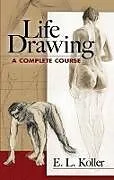Autorentext
Klappentext
Inhalt
E. L. Koller was an artist and author, a member of the American Federation of Arts, and the Director of Art Schools, International Correspondence Schools.
Klappentext
The human figure, with its myriad curves and contours, can be challenging for anyone to draw. In this invaluable reference, well-known art instructor and author E. L. Koller simplifies the process, making it easy for artists to learn new methods of rendering the figure?in action and repose?with accuracy and style.
Using figure-drawing exercises, numerous photos, and illustrations, Koller reduces the task at hand into manageable steps for intermediate and advanced artists. Beginning with drawing basics, this step-by-step guide explores the structure of the human figure and the comparative proportions of child and adult figures, showing how to depict individual parts of the head and body, facial expressions, and gestures. It also shows the merits of sketching from memory; drawing from casts, photographs, and living models; and sketching both undraped and costumed figures. Once the still figure is mastered, the artist can explore the more challenging action poses, including walking, running, and catching. Filled with guidance and insight on the human form, Life Drawing is an essential addition to every artist's reference shelf.
Using figure-drawing exercises, numerous photos, and illustrations, Koller reduces the task at hand into manageable steps for intermediate and advanced artists. Beginning with drawing basics, this step-by-step guide explores the structure of the human figure and the comparative proportions of child and adult figures, showing how to depict individual parts of the head and body, facial expressions, and gestures. It also shows the merits of sketching from memory; drawing from casts, photographs, and living models; and sketching both undraped and costumed figures. Once the still figure is mastered, the artist can explore the more challenging action poses, including walking, running, and catching. Filled with guidance and insight on the human form, Life Drawing is an essential addition to every artist's reference shelf.
Inhalt
Line Drawing
Purpose
Materials and Methods of Work
Materials Required
Methods of Work
Line-Drawing Exercises
Preliminary Practice Work
General Information
Model Drawing
Purpose
Materials and Methods of Work
Materials Required
Blocking in and Proportioning
Foreshortening
Foreshortening of a Cube
Foreshortening of a Pyramid
Foreshortening of a Hexagonal Prism
Foreshortening of a Cylinder
Foreshortening of a Cone
Foreshortening of a Sphere
Foreshortening of a Hemisphere
Foreshortening of a Vase
Model Drawing Exercises
General Information
Light and Shade
Three Stages in Learning to Draw
Light, Shade, and Shadow
Sources and Kinds of Illumination
Light and Shade
Demonstrations with the Wooden Models
The Cube
The Pyramid
The Hexagonal Prism
The Cylinder
The Cone
The Sphere
The Hemisphere
The Vase
Materials and Methods of Work
Preliminary Practice
Rendering from the Model
Drawing Exercises
General Information
The Human Figure
Place of Human Figures in Illustrating
Framework of Figure
Methods of Proportioning Entire Figure
Importance of Individual Parts of Figure
The Head
Neck and Shoulders
Breast and Abdomen
Shoulder, Arm, and Hand
The Thigh, Leg, and Foot
The Face and Its Features
The Eye
The Nose
The Mouth
The Ear
The Chin
Figure Drawing Exercises
General Information
The Figure in Repose
Repose
Drawing from Casts
Cast of Head
Cast of Hand
Cast of Foot
Cast of Full-Length Figure
Drawing From Charcoal Studies
Examples of Charcoal Studies
Drawing from Living Methods
Living Models and Their Arrangement
Studies Made Direct From Living Models
Figure Drawing Exercises
General Information
The Figure in Action
Action
Drawing from Photographs
Use of Camera
Specimen Photographs of Action
Making Sketches from Photographs
Drawing from Living Models
Making Time Sketches
Sketches from the Undraped Figure
Making Rapid-Action Sketches
Making Sketches from Memory
Drawing Expressions and Drapery
Facial Expressions
Portraiture
Gesture
Drapery
Figure Drawing Exercises
General Information
Animal Drawing
Place of Animals in Illustrating
Proportions of Animal Figures
Comparative Sizes of Animals and Human Beings
Comparative Anatomy of Animals and Human Beings
Characteristic Appearance of the Most Common Animals
Chief Characteristics to be Observed
The Principal Animals
Method of Drawing Animals
Typical Forms of Action in Animals
Drawing from Pictures of Animals
Drawing Direct from Animals
Suggestions for Sketching Animals
Animal Drawing Exercises
General Information
Titel
Life Drawing
Untertitel
A Complete Course
Autor
EAN
0800759136155
ISBN
978-0-486-13615-8
Format
E-Book (epub)
Hersteller
Herausgeber
Veröffentlichung
08.03.2012
Digitaler Kopierschutz
Adobe-DRM
Dateigrösse
16.42 MB
Anzahl Seiten
224
Jahr
2012
Untertitel
Englisch
Unerwartete Verzögerung
Ups, ein Fehler ist aufgetreten. Bitte versuchen Sie es später noch einmal.
